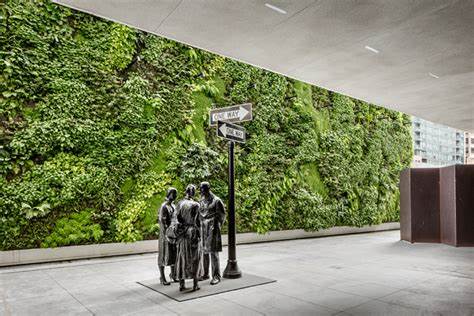
Vertical Gardens as Art Installations: Exploring Nature and Creativity in Urban Spaces
Introduction
Vertical gardens, also known as green walls or living walls, have gained significant attention as innovative and artistic installations in urban environments. This article delves into the world of vertical gardens as art installations, exploring their historical background, key concepts, main discussion points, case studies, current trends, challenges, and future outlook. By integrating nature and art, vertical gardens have the potential to transform urban landscapes and enhance the well-being of communities.
Historical Background
The concept of vertical gardens as art installations traces back to ancient civilizations such as the Hanging Gardens of Babylon. However, it wasn’t until the 20th century that artists began incorporating living plants into their creations. Influential artists like Patrick Blanc and notable installations like the Vertical Garden at CaixaForum in Madrid have contributed to the popularity and recognition of vertical gardens as art forms.
Key Concepts and Definitions
Vertical gardens are defined as vertical structures covered in plants, creating a living artwork. These installations serve as a harmonious integration of nature and art, blurring the boundaries between indoors and outdoors. By bringing greenery into urban spaces, they provide numerous benefits to the environment and the people who interact with them.
Design Principles and Techniques in Vertical Gardens as Art Installations
Vertical gardens employ a diverse range of plant species, carefully selected for their adaptability and aesthetics, to add depth and visual interest to the installation. The strategic use of plants with different colors and textures creates a visually appealing composition, achieving contrast and harmony. Maintaining the balance between allowing plants to thrive and adhering to the artistic vision is crucial, involving regular pruning and monitoring.
Environmental Benefits of Vertical Gardens as Art Installations
Vertical gardens act as natural insulators, reducing the heat absorbed by concrete and buildings, thus mitigating the urban heat island effect and lowering energy consumption for cooling. They also play a vital role in purifying the air by absorbing pollutants and releasing oxygen, contributing to a healthier and cleaner urban environment. Additionally, vertical gardens provide habitats for various plant and animal species, promoting biodiversity in urban areas and supporting local ecosystems.
Impact on the Urban Landscape and Community
Vertical gardens beautify urban spaces, transforming concrete jungles into vibrant and captivating environments. They create interactive and engaging settings that encourage people to connect with nature, promoting relaxation, stress reduction, and overall well-being.
Case Studies or Examples
The Vertical Garden at CaixaForum in Madrid, Spain: Designed by Patrick Blanc, this iconic vertical garden covers the entire exterior of a museum, showcasing a diverse range of plants and making it a landmark attraction.
Patrick Blanc’s Vertical Garden Installations: Blanc’s work can be seen worldwide, with vertical gardens adorning buildings in cities like Paris, Singapore, and Miami. His innovative designs have greatly influenced the field of vertical gardens as art installations.
The Bosco Verticale in Milan, Italy: This award-winning vertical forest consists of two residential towers covered in over 900 trees and thousands of plants. It serves as an exemplary model of how vertical gardens can be integrated into urban living spaces.
Current Trends or Developments
Vertical gardens are embracing technology, with the use of automated irrigation systems, sensors, and monitoring tools to optimize plant health and maintenance. Sustainable materials, such as recycled and locally sourced components, are also being incorporated into the construction of these installations. Furthermore, research is being conducted to explore the health benefits of interacting with vertical gardens, including improved mental health and productivity.
Challenges or Controversies
Maintenance and sustainability pose challenges for vertical gardens. Proper care and regular maintenance are essential to ensure the longevity and vitality of the plants. The costs associated with large-scale installations and ongoing maintenance can be prohibitive, making funding a significant challenge. There is also a perception that vertical gardens are a luxury rather than a necessity, which may limit their widespread adoption.
Future Outlook
The potential for expansion of vertical gardens as art installations in urban areas is vast. Collaborations between artists, architects, and horticulturists can further push the boundaries of creativity and innovation. As sustainable urban planning gains more prominence, vertical gardens may become integral components of green cities, enhancing the quality of life for residents and visitors alike.
In conclusion, vertical gardens as art installations offer a harmonious blend of nature and creativity, transforming urban spaces into oases of greenery. They provide environmental benefits, beautify the urban landscape, and positively impact the community’s well-being. With continued advancements and collaborations, vertical gardens have the potential to shape sustainable and vibrant cities of the future.
References
Blanc, Patrick. The Vertical Garden: From Nature to the City. W. W. Norton & Company, 2012.
CaixaForum Madrid: Vertical Garden. Retrieved from https://www.caixaforum.es/en/madrid/home
Mahdavinejad, M., et al. (2020). Green wall systems: a review on vertical vegetated complex walls. Sustainable Cities and Society, 55, 102051.
Woolley, H., et al. (2019). The Impact of Green Walls on wellbeing and air pollution in urban environments: A systematic literature review. Sustainable Cities and Society, 47, 101488.